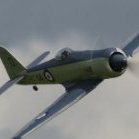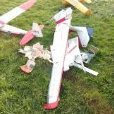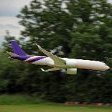Leaderboard
Popular Content
Showing content with the highest reputation on 07/03/23 in all areas
-
With all the silver soldering complete (the large brackets are for fixing the undercarriage to the formers and will be bent to accurately fit when the formers have been made) it’s time to add the wood cladding. The legs on some SE5a’s were wrapped with linen so hard balsa could be used for the cladding but the particular aircraft I’m modelling didn’t have wrapped legs, they were left as natural wood, so spruce is the material of choice. As is sadly often the case these days my local model shop could supply me with an ARTF cloned SE5a but a sheet of 1/8 " spruce is another matter! The next best option was a length of “strip wood pine” from B&Q. All the blanks are fret sawed out, the fronts routed to take the piano wire then clamped and glued using slow epoxy before the rears are routed so ensuring a good join. I've got a couple of Black & Decker routers but the best way I’ve found to rout the blanks is to use an appropriate sized “ball ended“ router bit fitted to an electric drill in a vertical drill stand, adjust the height to cut half depth of the piano wire. Hold the blank in place and draw round the piano wire then rout down the middle of the lines. The bit doesn’t have to be exact size, once the router has done it’s job a piece of the correct gauge piano wire dragged down the groove will soon make for a good fit. What better on a rainy Sunday afternoon than spending a couple of hours in the modelling room happily “Dremelling” away at the SE5a’s undercarriage? The first coat of stain has shown up a few areas that require extra work so it’ll be out with the sand paper before the next coat. Then light sanding between coats to build up the “depth” of colour to represent the original hardwood.5 points
-
4 points
-
I sent my photos off to a company to do mine, a real letdown although they did give me blue eyes,,,😇so I molded one scraped and whittled it down and remolded a couple this is my last one painted.3 points
-
IMAX B6 AC-DC Lipo Balance Charger. This covers the majority of charging requirements.3 points
-
More flights as soon as the weather improves 🙂 Until then, there are plenty of details to improve and to work further on. Timo3 points
-
Some years ago I calculated the nominal volume of air moved by propellers/rev as a means of comparing the loads they presented (in my case to electric motors but presumably the same applies to liquid fuelled engines). ( pi 0.5 dia ^2 x pitch) Obviously it's quite crude as it doesn't take account of the propeller design but I find it helps. Low pitch propellers are really like low gears in a car or motorcycle. If you want performance at low speed as in (say) funfly type model then low pitch is the way to go (eg I used 11x3 props with ST34 engine on my Limbo dancer). Most of my models are low speed types like 1930s style biplanes and I tend to use a lot of 12x6 or 13x6.5.2 points
-
Hi Jon. Air tool oil is an excellent oil to build and store engines. It doesn't dry out like many oils. I have engines In my collection that were stripped , cleaned and re-assemble with this oil many years ago and they still turn freely. It only works on clean engines . If any other oil or contaminants remains in the engine they will stiffen up . Cenga oil is IMO best but most air tool oils are pretty good as they are made to resist any moisture that is in the compressed air flowing through the tools and it doesn't attack "0" rings . Used that for vintage rebuilds that are likely to sit on a shelf for some years now. For engines that are being repaired or refurbished for running I use two stroke oil and prefer Carlube . It's also a handy additive for diesel fuel . I used it for years in my cars at ratio of 300 : 1. It quickly mixes and clears out of an engine and never had any problems. Obviously there are other makes available .2 points
-
A bit late, but flying Sunday....I don't think I have my "twins" obsession under control at all! Even one of the other club members brought his foamy twin as well ☺️ Really getting the hang of the Peter Miller Grumpy Tiger Cub with massive full power full throws loops rolls and bunts. far more scale with a couple of flights of the P38. Still surprised at how well the P38 flies considering its weight.2 points
-
Plus dont pay, we want an equal playing field. 🙊 I think you have to pick a team before you can join a league2 points
-
Which hobby are we talking about? Aeromodelling or operating a device solely for acquiring images to stick up on YouTube? I think the difference is important.2 points
-
Reducing the prop diameter will reduce the thrust, due to the reduced area of air being moved. As a rough rule of thumb, if you increase the pitch the power required will go up by the same percentage, i.e. 5 to 6" pitch will be roughly 20% more power, but diameter is the square, so going from a 9 to a 10" diameter will be 100/81, so roughly 20%.2 points
-
I don't think anything that enhances your building/flying pleasure is cheating. And pretty much everything needs you to learn or improve new skills. Great woodwork and use of modern technology on show!2 points
-
Another Depron plane that was built because I wanted a scale and compact Super Cub but ended up sub 250 g. Just so every body knows it is writ large on the wing! A one piece plane with a span of 1015mm (40"). The balsa wing struts are substantially load bearing as the wing is hollow with 2mm Depron skins and it has no spar, just a Depron shear web. The Alaska wheels are built up from 6mm grey Depron with acetate hubs. An Emax 2205 2500kv with a 7x6 prop provides the power which is supplied from a 1000 mAh 2s. It uses 4x3.7g servos (ailerons, elevator and rudder). The rudder is vital as adverse aileron yaw is very pronounced. Not a very exciting video but it is edited down from a not very exciting 26 minute flight! https://www.youtube.com/watch?v=rMUNaJQDaX02 points
-
Hi everyone, just to let you know that having the plans available to digital users in this form is just a stop-gap. We had so much feedback when they weren't available that we thought this quick fix was better than nothing in the short term. The archive platform we use forces all the pages to be the same size - so they are downsized to A4. The next phase will be to incorporate full resolution versions behind a login area. I love the idea of dropbox, but need to find a way of authenticating subscribers.2 points
-
It really was a superb webinar by Ron - who not only demistified Fusion 360, with one dimension tied behind his back, but also Litburn and a practical demo of the laser cutting itself - all in <45 minutes. Brilliant stuff. 😎1 point
-
A brilliant session from Ron this evening. Really was very interesting. Video available to watch at https://www.youtube.com/watch?v=YkoRFeKO00o1 point
-
1 point
-
1 point
-
Thanks Chris. Yes indeed Freddie's sauce is very popular and works really well. I used it on my Spitfire and it produced such a smooth surface.1 point
-
That's not a terrible idea Ron, but we want to discourage people sharing an open link wherever possible.1 point
-
Hello Frank The D7 doesn't have rigging wires so there is not as much drag as with the SE5a but having said that the model size relative to engine size seems to vary considerably with available plans. This is a retrospective thread, the model has flown and the Laser 70 was fine with a bit of wind to assist take off but marginal in a flat calm. Hope you enjoy the rest of the thread' Grahame1 point
-
As always, you cant tune an engine by counting turns. Its common to see recommendations about tuning engines based upon numbers of needle turns, relative position of components or other cosmetic or visual clues. Ultimately none of these things matter though and the only option to run the engine and tune it using the performance of the engine to inform you on what to do. It would be the same as trying to tune a stringed musical instrument by counting the turns on the tuners or seeing if they were all aligned in some cosmetic way. Needless to say, this wont work! If you have trouble with engine still after the rebuild post a video showing the issue as the sound of the engine is a big aid to diagnosing the problem. Just keep the camera out of the prop blast as wind noise is not informative 😉1 point
-
1 point
-
Don't be so sure. Chuck gliders are very easy to handle and it's surprising how far one can throw them!1 point
-
I'm still very happy a lot of modelers seem to like Freddie B's (Secret) Sauce... I first used it on my Depron take of Peter's Ballerina and then shared it with the community. ... "some water moved under the bridges" since then, I guess. Get well soon, Peter. Cheers Chris1 point
-
1 point
-
Time to add a bit of metal work. First the outline and fixing points are drawn onto thin card that is then covered with sellotape, which both strengthens and protects, before cutting out. The shape is then transferred onto litho plate as many times as required. The shape can be cut out quite easily with kitchen scissors, not the wife’s best, it’s a good idea to buy a pair especially for this job. Once the shape is cut out turn it over for final sanding of the edge, this shows up any slight imperfections that would be “masked” by the drawn outline. The fixings are embossed from the reverse side; “rivets” using an old ballpoint pen, the bolt heads using a nut soldered onto a bolt. The undercarriage legs are looking a lot better now with a few coats of stain.1 point
-
Yes confiscation of articles can be undertaken and frequently does as it forms part of assorted laws prescribed to law enforcing agencies. I have no quibbile with punishment given to the culprit. That said the curfew is certainly over the top. Very few models are flown during the dark and very rarely do curfews get imposed on burglars...1 point
-
Even though a Hurricane is 'designed to be shot at', I'm pretty sure there are a number of scenarios that could bring it down..... jammed control surface, manages to penetrate the cockpit and hits pilot, breaks a control cable, jams undercarriage, jams an air intake etc. etc. Irrespective if the likelihood, it's possible and that idiot completely ignored this just to get some good footage. Low probability, very high impact makes it a risk that needs mitigating, or better still, removing. Hopefully the police destroyed all his equipment.1 point
-
We have an unwritten rule in our club that when someone is starting an engine you don’t talk to them (not always observed I have to say). It’s often distraction from other people, or a change in your usual routine that leads to accidents.1 point
-
Thanks for the update @dhendley. Although I was a little grumpy to begin with I found a work around and it's all good but I do look forward to having the full size plans available once it is sorted out. Thanks in general for offering up the plans digitally 👍1 point
-
Making good progress on the rear end, spent some time today adding some details to the Sierra tailwheel unit, this is semi scale so the final look will be a compromise, on the new S8 i will make from scratch so in keeping with the full size. First was to make the tyre and hubs, been making these for some years and supplying Sierra Giant Scale with 1:5....1:4.5 and 1:4 scale as they are foam, they are very light. The main changes to the unit is reshaping the yolk with files, adding a fillet radius at the top of the yolk with filler.....adding new axle ends, the screw that holds the axle in place has been replaced and the head diameter ground down, this now fits inside the new axle end. Some round shaped model lab board parts.....also ordered some Milliput epoxy filler for the welds which need adding......hopefully the final look will be better than the standard brought tailwheel assembly..1 point
-
With the decision made that my next scale model is to be an SE5a the search begins for a suitable plan; if someone has done all the hard work for you what’s the point in doing it all again and designing from scratch? I will use one of my trusty Laser 70s but was unable to find a suitable plan for this size engine so first some calculations from a simple 3-view drawing downloaded from the Internet. The first thing to determine is the size; this may not be quite as simple as it seems, a flick through the plans hand book shows models of a similar design i.e. biplane with rigging wires, varying from 80” span for a 48 – 52 four stroke to 56” span for 80 – 90 two stroke (therefore at least a 90 four stroke). The method I use is to work out a minimum size that will allow the engine to be fully enclosed then go bigger to make it the correct size for commercially available accessories, usually wheels. My argument for this method is that you can never have too much power if you need it, but you can always use less throttle and a larger diameter prop to fly in a scale manner. In this instance it equates to 58” span for 5” Williams Bros. vintage wheels. The next consideration is how scale? As I was going to have to redraw the plan anyway I chose the most accurate I could find, the plan was ordered and then reduced by Prontaprint. I intend to trace the outline then design my own internal construction as I hope to be modifying the plan to allow for some extra scale detail. Before any design work can start I need to confirm the viability of such modifications by making test parts / jigs etc. One of the notable features on the SE5a is the transparent inspection windows for the aileron and elevator linkage. These need to incorporated for scale authenticity so I want to make them at least have the appearance of “working” if at all practical.1 point
-
Well done Charles, Igor and Grumpy. I started in my customary 12/13th place where I will probably remian for the duration. Well done to Alonso as well. John1 point
-
I’ve had a couple of iffy front bearing fits on the old red Irvines. Typically, it manifests as refusal or delay in cutting the engine with a completely closed carburettor. Assembling the front bearing with a smear of Loctite Bearing Fit or similar cures this.1 point
-
Congrats to Charles, Igor & GG Well done, gents... Considering my personal circumstances, I can only be fairly happy ending just behind our winning trio. Even despite Charles L's DNF and 'not that great' predictions, my score remains pretty acceptable. Jeddah, here we come... Cheers Chris1 point
-
Seat almost finished......some small details to add plus the harness strap fixings.....and the rear seat location points... Interesting to see the difference between the correct scale and the supposed 1/5 scale from Aeroteam which i bought some years ago......have to replace the 2 i have in my A8 and D9 as well..1 point
-
Before finishing the planking on the sides i need to complete the rudder/elevator linkage/movement, so finished the rudder today, inserted scale hinge points.. once i'm happy with everything i'll add solatex to the surfaces Still pleased with the overall weight with the tail surfaces attached Also printed he seat bucket...:-)1 point
-
I don't think that's the point. To quote the prosecution barrister, "It is the last Hurricane ever built and it is considered priceless.". And as she pointed out, there are only 12 airworthy Hurricanes left in the world. So to risk losing the aircraft or even just getting it damaged in an avoidable accident would seem unconscionable.1 point
-
An update! instead of the pre shaped ends I'm now providing a U chose U cut option where the shapes have been partially cut so you can decide which ones you want. Prices as before: Standard £22 inc postage U chose U cut £25 inc postage Watch this space as an XL version will be coming soon!!!1 point
-
I would argue that a ‘reasonable result’ is not the same as ‘identical’ to the full size printed version, therefore we still need access to an electronic (ideally dxf) version.1 point
-
1 point
-
If you want something that flies itself then a Hobby Zone Carbon Cub S, all the bells and whistles including Exclusive SAFE Plus GPS-enabled drone technology. • AutoLand, Holding Pattern, and Virtual Fence functions. • Beginner, Intermediate, and Experienced flight modes. • EPO foam airframe with fully painted scale trim scheme. • Tundra tires. On the up side you won't need a lot of skill to fly it, on the down side you won't learn much about flying either..and what it will teach you will need unlearning if you progress to something else. Alternatively as suggested by many, find a club, talk to the club members and get a few trial flights before deciding on equipment and instruction. 🙂1 point
-
1 point


(2020_03_2622_00_27UTC).thumb.gif.375a6ebc5cd681eb724c62879a10ef8d.gif)













.thumb.jpg.6e9ca6f431386c6c58ab30794f332751.jpg)


